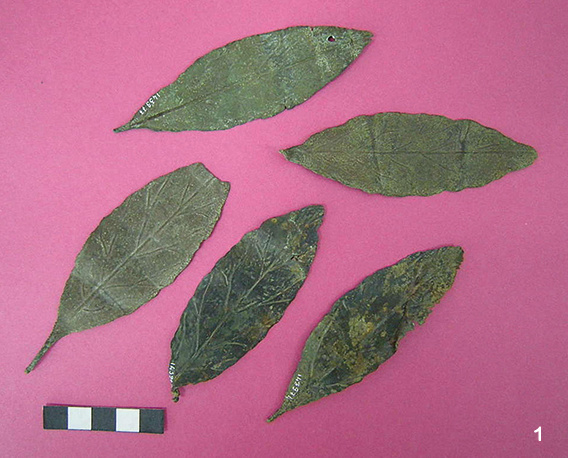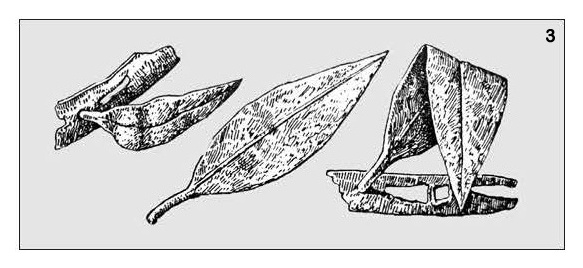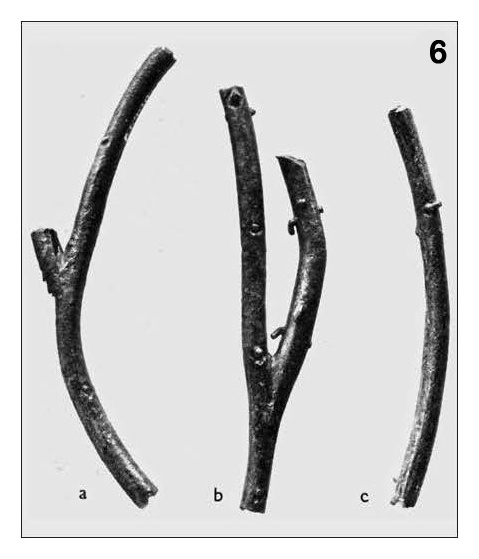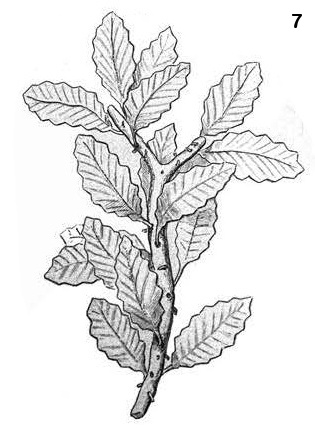
In the 1980s an ‘enormous number’ of bronze laurel leaves were excavated (De Siena, Metaponto Scoperte, §1.3) from the area of a large stone platform and well, located within the market of Metapontion, confirming to archaeologists that they had discovered the site of the Metapontine sanctuary to Apollo described by Herodotos and in a a story retold by Athenaios. According to those accounts, the sanctuary was built because Aristeas of Prokonnesos commanded it during a supernatural visit centuries after his natural life.
The bronze leaves testify to the practice at the sanctuary of a religious rite, well attested in archaeology, in which highly realistic bronze reproductions of tree branches with attached bronze leaves were produced and brought to sanctuaries of Zeus and Apollo, apparently as votive donations (Castoldi, Albero di Bronzo, 29-41). Bronze reproductions of oak branches were brought for Zeus, attested from major sanctuaries in Dodona and Olympos, while bronze reproductions of laurel branches were brought for Apollo, attested at sanctuaries near Kaulonia and Kroton in southern Italy, and at Klaros in Ionia.
No bronze branches were found at the Metapontine market sanctuary, but since branches are naturally more likely to be recycled, their use has been inferred at Metapontion by comparison to nearby Kaulonia and Kroton. The same inference has been drawn for the sanctuary of Monte Papalucio near Oria, where many bronze leaves were excavated (Mastronuzzi, Monte Papalucio, 210-211). It is much less clear whether bronze leaf-shaped plates found at Colla near Rivello were used in a similar way (ibid.; Castoldi, op. cit., 17).
The branches were composed of hollow sections that could be joined together by inserting the knob that protruded from the bottom end of a section into the hole made to accept such knobs at the top end of another section, much like modern Lego toys (the knobs are best visible in image 4b). Leaves were attached to the branch sections by thin, angled extensions from the leaves’ stems, which were inserted into small holes through the walls of the hollow branch sections. This loose method of attachment allowed the leaves to dangle, giving the leaves a realistic jostling effect when the branch was moved or the wind blew, making the branch a kind of wind-chime.
These bronze laurel branches came into use at around the same time as a new type of depiction of Apollo carrying a laurel branch, known as Apollo Daphnephoros (‘laurel-carrier’), on both coins and painted ceramics, at around the turn of the Archaic to Classical periods (Castoldi, op. cit., 33-35). The only extant text that seems to mention the bronze branches is the story told by Athenaios in which ‘the bronze laurel … set up during the visit of Aristeas’ made a sound or voice (φωνή) when a women came near wearing a crown that had been looted from the sacred treasuries of Delphi, which led a group of diviners to fly into a rage and kill her.
The main way this text has been understood, by Antonio De Siena followed by Marino Castoldi, Giovanni Mastronuzzi (op. cits.) and Ettore De Juliis (Metaponto, 170-173), is that the bronze laurel of the story referred to a permanent bronze laurel tree that stood near the well and platform. In this interpretation, a statue of Apollo holding a large laurel branch, as depicted on Metapontine coins, stood separately on a second platform further to the south. Alternately, Attilio Stazio (Monetazione di Metaponto, 83) and Joseph Coleman Carter (Countryside at Metaponto, 217) suggested the bronze laurel of Athenaios’ story referred to the statue’s laurel branch, and David Hernández Castro (El Temenos, 119-120) proposed that the Apollo statue with large laurel branch stood on the more northern of the two platforms. Hernández Castro suggested the bronze leaves could have been attached to a natural branch that was placed in the statue’s hand in a regular renewal ceremony.
Two other aspects of Athenaios’ story subject to interpretation are its reference to the bronze laurel making a sound or voice (φωνή), and a group of diviners become enraged when they heard it. De Siena (op. cit.) proposed that the φωνή made by the bronze laurel was the chiming noise made when the bronze tree’s leaves jostled, and Mastronuzzi (op. cit.) further proposed that the tale of diviners reacting to the φωνή reflected a regular practice among diviners of interpreting the chiming of Apollo’s sacred bronze tree.
Although Roman-era writers such as Iamblichos associated reverence for Aristeas with Pythagoreanism, and Metapontion and south Italy figured prominently in legends about the life of Pythagoras and early Pythagoreanism, there is no evidence that the use of bronze laurel branches and leaves in Apollo worship was particularly related to Pythagoreanism. On the connection between Pythagoreanism and reverence for Aristeas in Metapontion, see the commentary on the site of the Apollo sanctuary where Aristeas’ statue stood.
Bronze leaves were also produced for placement on wreaths and crowns, and at some sites where they have been found, such as Delphi and the Athens Akropolis, bronze leaves seem most likely to have served that purpose (Castoldi, op. cit., 29-30). Bronze laurel leaves found in Boiotia were produced in connection with a regional ritual procession known as the Daphnephoria (Kowalzig, Singing for the Gods, 371-391). It has been proposed that metal leaves might have been used in rites connected to ritual throwing of natural leaves mentioned in ancient literature (Milanesio Macri, Thesmophorion, 340).
The Metapontines also produced highly realistic reproductions in gold of ears of wheat, some of which were donated to Delphi (Castoldi, op. cit., 18-24; Strabo 6.1.15).






Date of Work: c. 450 BCE
Key to images:
1, 2. Votive bronze laurel leaves from the Apollo sanctuary in the market of Metapontion, Italia. (1: Castoldi, Alberi di Bronzo, p. 39, fig. 15, cm. scale; 2: Bottini, Archeologia della Salvezza, fig. 21)
3, 4. Votive bronze laurel leaves and branches from the Apollo Aleo sanctuary of the Kroton chora, Italia (Castoldi, op. cit., p. 37, figs. 13-14.)
5. Votive bronze branch from the Apollo sanctuary of Klaros, Ionia. (Ibid., p. 34, fig. 11)
6. Votive bronze branches from the Zeus sanctuary of Olympos, Peloponnesia. (Ibid., p. 31, fig. 9)
7. Reconstruction of a votive bronze branch with attached bronze oak leaves, from the Zeus sanctuary of Dodona, Epeiros. (Ibid., p. 32, fig. 10)